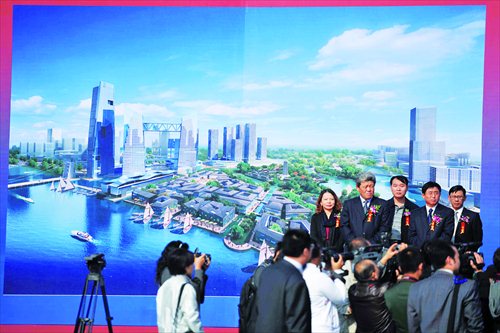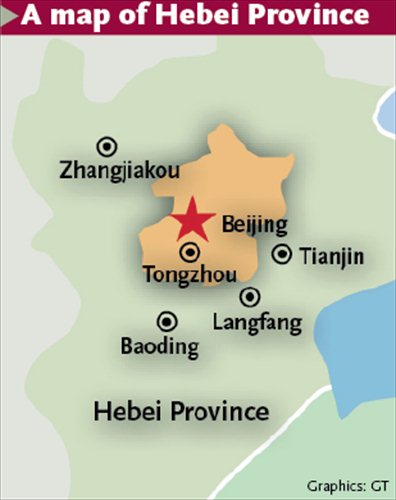HOME >> BUSINESS
Distant district set to shine
By Yang Jing Source:Global Times Published: 2015-7-15 20:18:31
Development plan for Greater Beijing promises big things for Tongzhou
The Tongzhou district in Southeast Beijing has finally been confirmed as the capital's sub-administrative center, a move that is part of the central government's regional development strategy. The news has caused a surge in housing prices in the district and has raised concerns about whether it can meet the needs of the coming population blitz. Experts said it is essential to improve public services including education, healthcare as well as transportation, though the efforts made in Tongzhou could end up as a model for other large Chinese cities dealing with similar problems.


"Beijing's subcenter" - a slogan on the website of Tongzhou district government may finally come true after the Beijing municipal government said at a meeting over the weekend that Beijing will accelerate its plan to build Tongzhou into its sub-administrative center.
Ten years of waiting
Beijing will accelerate the shift of its non-capital functions to Tongzhou district and progress should be evident by 2017, the Beijing government said when it approved an implementation guideline for the Beijing, Tianjin and the adjacent Hebei Province coordinated development plan.
Four major Beijing authorities, the capital's Party committee, the municipal government, Beijing Municipal People's Congress and Beijing Municipal Committee of the Chinese People's Political Consultative Conference, will move to Tongzhou before 2017, a person close to the matter who declined to be named told the Global Times Tuesday.
Other departments of the Beijing authorities will move to Lize financial business district, which is located in Fengtai district, in southern Beijing, the source said, noting the move may not be achieved until after 2017.
In 2004, a Beijing development plan said it would establish 11 new districts, with Tongzhou designed as a supplementary district for the city's administration, according to the Tongzhou district government's website.
In 2012, Beijing officially designated Tongzhou as a subcenter and vowed to accelerate the plan laid out in the 2013 and 2014 Beijing municipal government work reports. However, compared with the ambitious plan, little progress has been made over the past decade.
For several years, Tongzhou has set aside land presumed to be for future municipal authorities, Zhang Wuming, a director of the regional strategy research center at the Beijing-based FangTang Think Tank, told the Global Times Sunday.
To live and work
"[The move to Tongzhou] will be inconvenient for us due to traffic," a civil servant in a Beijing municipal department who prefers to remain unnamed, told the Global Times Tuesday.
The concern over daily commute is easy to understand, especially considering Beijing's much-lamented traffic congestion.
"It takes at least an hour to get from my home in Tongzhou to my office in the CBD," a Beijing resident surnamed Lin told the Global Times Monday, "Although I have a car, I have to take bus and metro. The traffic makes driving to work impossible because you can never tell how much time it will take."
In addition to traffic issue, Lin also said that Tongzhou lacks sufficient public service institutions.
"There are not many good hospitals and schools here so I have even considered moving somewhere else," said Lin, who has two children.
According to a report the Beijing Academy of Social Sciences released in June, Tongzhou ranked at the bottom among Beijing's 16 districts and counties in terms of public services.
But Lin decided to wait. With the municipal authorities coming, she believes more public service facilities will be built in Tongzhou.
Better public service facilities are not only expected by local residents but also required for the plan to be an effective solution to Beijing's "urban disease."
If the relocated residents only work in Tongzhou but do not live there, traffic congestion may get worse due to their daily commute, Zhang said. It is certain that Tongzhou will become a place for these relocated residents to work and live, Zhu Erjuan, a professor at Capital University of Economics and Business, told the Global Times Monday.
The move is a complicated process and needs to be carried out in an orderly sequence, so an overall plan for public service development in Tongzhou, including transportation, education and healthcare, will come later, Zhu said, noting that the supporting facilities and services in the district will be improved.
However, regardless of the public service level, the news of municipal authorities' move has spurred a spike in home prices.
The housing price for a home in a community near a place said to be reserved for Beijing municipal authorities has increased to 35,000 yuan ($5,638) per square meter this month, Lin said. Last year, the price was 22,000 yuan per square meter.
National development plan
Setting Tongzhou as a sub-administrative center is a part of the decentralization of Beijing's non-capital functions, which is the primary goal of the Beijing-Tianjin-Hebei region coordinated development plan, Zhu said.
The excessive concentration of administrative departments is a main cause of Beijing's "urban disease" and imbalanced public service resources in different districts also exacerbated population concentration in the urban area, Zhang said.
Beijing has put a lot of effort in recent years to easing overcrowding but has made little progress, according to Zhang.
Under the Beijing-Tianjin-Hebei region coordinated development plan, Beijing aims to control population growth.
With a population of 21.52 million as of the end of 2014, Beijing aims to strictly control its population growth to keep the total under 23 million by 2020, the Xinhua News Agency reported Sunday, noting the capital expects to relocate 15 percent of the urban population.
For overburdened large cities, a subcenter can share functions, reducing population growth in crowded urban area and maybe become a new economic growth engine, Zhu said, noting that Tongzhou will be a key model for other Chinese cities.
Meanwhile, sound development in Tongzhou, which borders Hebei Province, may also encourage more cooperation between Beijing and the province, Zhu said.
Many cities in Hebei, such as Baoding, Langfang and Zhangjiakou, are willing to accept Beijing's function shift, but Beijing has hesitated to ease its hand, Zhang said, noting with the decision made by central government, there will be a bright future for the three places in the development plan.

A rendering of the future downtown of Tongzhou district in Beijing. Photo: CFP

A map of Hebei Province. Graphic: GT
"Beijing's subcenter" - a slogan on the website of Tongzhou district government may finally come true after the Beijing municipal government said at a meeting over the weekend that Beijing will accelerate its plan to build Tongzhou into its sub-administrative center.
Ten years of waiting
Beijing will accelerate the shift of its non-capital functions to Tongzhou district and progress should be evident by 2017, the Beijing government said when it approved an implementation guideline for the Beijing, Tianjin and the adjacent Hebei Province coordinated development plan.
Four major Beijing authorities, the capital's Party committee, the municipal government, Beijing Municipal People's Congress and Beijing Municipal Committee of the Chinese People's Political Consultative Conference, will move to Tongzhou before 2017, a person close to the matter who declined to be named told the Global Times Tuesday.
Other departments of the Beijing authorities will move to Lize financial business district, which is located in Fengtai district, in southern Beijing, the source said, noting the move may not be achieved until after 2017.
In 2004, a Beijing development plan said it would establish 11 new districts, with Tongzhou designed as a supplementary district for the city's administration, according to the Tongzhou district government's website.
In 2012, Beijing officially designated Tongzhou as a subcenter and vowed to accelerate the plan laid out in the 2013 and 2014 Beijing municipal government work reports. However, compared with the ambitious plan, little progress has been made over the past decade.
For several years, Tongzhou has set aside land presumed to be for future municipal authorities, Zhang Wuming, a director of the regional strategy research center at the Beijing-based FangTang Think Tank, told the Global Times Sunday.
To live and work
"[The move to Tongzhou] will be inconvenient for us due to traffic," a civil servant in a Beijing municipal department who prefers to remain unnamed, told the Global Times Tuesday.
The concern over daily commute is easy to understand, especially considering Beijing's much-lamented traffic congestion.
"It takes at least an hour to get from my home in Tongzhou to my office in the CBD," a Beijing resident surnamed Lin told the Global Times Monday, "Although I have a car, I have to take bus and metro. The traffic makes driving to work impossible because you can never tell how much time it will take."
In addition to traffic issue, Lin also said that Tongzhou lacks sufficient public service institutions.
"There are not many good hospitals and schools here so I have even considered moving somewhere else," said Lin, who has two children.
According to a report the Beijing Academy of Social Sciences released in June, Tongzhou ranked at the bottom among Beijing's 16 districts and counties in terms of public services.
But Lin decided to wait. With the municipal authorities coming, she believes more public service facilities will be built in Tongzhou.
Better public service facilities are not only expected by local residents but also required for the plan to be an effective solution to Beijing's "urban disease."
If the relocated residents only work in Tongzhou but do not live there, traffic congestion may get worse due to their daily commute, Zhang said. It is certain that Tongzhou will become a place for these relocated residents to work and live, Zhu Erjuan, a professor at Capital University of Economics and Business, told the Global Times Monday.
The move is a complicated process and needs to be carried out in an orderly sequence, so an overall plan for public service development in Tongzhou, including transportation, education and healthcare, will come later, Zhu said, noting that the supporting facilities and services in the district will be improved.
However, regardless of the public service level, the news of municipal authorities' move has spurred a spike in home prices.
The housing price for a home in a community near a place said to be reserved for Beijing municipal authorities has increased to 35,000 yuan ($5,638) per square meter this month, Lin said. Last year, the price was 22,000 yuan per square meter.
National development plan
Setting Tongzhou as a sub-administrative center is a part of the decentralization of Beijing's non-capital functions, which is the primary goal of the Beijing-Tianjin-Hebei region coordinated development plan, Zhu said.
The excessive concentration of administrative departments is a main cause of Beijing's "urban disease" and imbalanced public service resources in different districts also exacerbated population concentration in the urban area, Zhang said.
Beijing has put a lot of effort in recent years to easing overcrowding but has made little progress, according to Zhang.
Under the Beijing-Tianjin-Hebei region coordinated development plan, Beijing aims to control population growth.
With a population of 21.52 million as of the end of 2014, Beijing aims to strictly control its population growth to keep the total under 23 million by 2020, the Xinhua News Agency reported Sunday, noting the capital expects to relocate 15 percent of the urban population.
For overburdened large cities, a subcenter can share functions, reducing population growth in crowded urban area and maybe become a new economic growth engine, Zhu said, noting that Tongzhou will be a key model for other Chinese cities.
Meanwhile, sound development in Tongzhou, which borders Hebei Province, may also encourage more cooperation between Beijing and the province, Zhu said.
Many cities in Hebei, such as Baoding, Langfang and Zhangjiakou, are willing to accept Beijing's function shift, but Beijing has hesitated to ease its hand, Zhang said, noting with the decision made by central government, there will be a bright future for the three places in the development plan.
Posted in: Insight